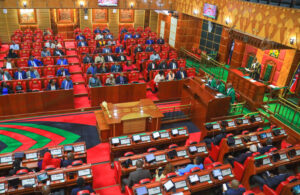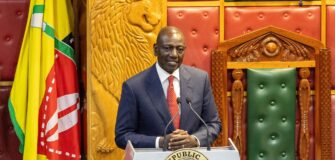Ruto Reveals 4 Strategic Actions to Move Kenya Forward
Share
President William Ruto has unveiled an ambitious national roadmap anchored on four major priorities aimed at propelling Kenya into a new phase of economic transformation, infrastructure expansion and human capital development.
The President said the government is committed to undertaking “four major national priorities,” which he described as the foundation for taking Kenya to the next stage of its growth.
“And that is why I am today submitting our roadmap to take Kenya to the next level,” he said, adding that the priorities represent the minimum required actions to secure the country’s long-term prosperity.
He told Parliament while addressing state of the nation, that the agenda begins with investments in education, scientific training and innovation.
“First, we must invest relentlessly in our people; in their education, skills development, scientific training, and innovation capacity,” he stated.
Also Read: Ruto Reveals Plans to Tackle Cancer Going Forward
Massive Boost to Education, Research and Innovation
President Ruto noted that the government has strengthened the education system through expanded funding and structural reforms.
He cited the rise in the education budget from KSh 490 billion in 2021 to more than KSh 700 billion this year.
“We have increased the education budget from KSh 490B in 2021 to over KSh 700B this year,” he said, insisting that the investment has translated into better infrastructure, more teachers and enhanced funding for colleges and universities.
He added that the government has created a State Department for Science, Research, and Innovation to accelerate STEM expansion and support research.
“This structure will also help actualise the 2% research fund needed to make this ambition a reality,” he said, calling for deliberate support for startups to commercialise innovation.
Ruto emphasised the need to expand national research funding from the current 0.8% of GDP to 2%, observing that the country faces a KSh 180 billion shortfall.
“Progressively, we should grow the fund to KSh 1 trillion over the next 10 years,” he said.
Irrigation Push to Transform Agriculture
On the second national priority, President Ruto announced a decisive shift toward irrigation-led agriculture to end dependence on rain-fed farming and reduce annual food imports worth KSh 500 billion.
“We can no longer allow the clouds to determine whether our people eat or not,” he said.
The Head of State pointed out that only 15% of Kenya receives adequate rainfall for farming, yet vast arid regions can be productive with water harvesting.
“We must never confuse the lack of rain with the lack of water,” he remarked.
Ruto revealed plans to build 50 mega dams, 200 medium and small dams and thousands of micro dams to bring at least 2.5 million acres under irrigation in seven years.
“With dams, we can transform our arid and semi-arid areas into hubs of agricultural production,” he added.
The mapped dam locations stretch across the country, including High Grand Falls, Isiolo-Barsalinga, Soin Koru, Rumuruti, Lowaat, Muhoya, Ndarugu, and Kokwanyo, among many others.
Also Read: Mudavadi Denies Claims Linking Ruto’s Family to Saudi Labour Exports
Energy Expansion to Power Industrial Growth
The President said the third priority is expanding the country’s power generation capacity to match future industrial, mobility and digital demands.
“No nation has developed without abundant, reliable, affordable power,” he declared.
Despite an installed capacity of 3,300MW, Ruto said firm capacity stands at just 2,300MW due to intermittence in solar and wind.
To meet demand, the country must add 10,000MW in the next seven years.
“We have to generate an additional 10,000 MW… to move our country to the next level,” he said.
Transport and Logistics Overhaul
He identified transport and logistics as the fourth major priority, noting Kenya’s position as a regional economic and diplomatic hub.
“Efficient transport and logistics are the backbone of our competitiveness,” he said.
Ruto said 2,500 highways have been earmarked for dualing and 28,000km of roads for tarmacking.
“Next week, I will launch the dualing of the 170-kilometre Rironi–Naivasha–Nakuru–Mau Summit road,” he announced.
Additional dualing projects include routes in Kiambu, Machakos, Nakuru, Kisumu, Bungoma, and coastal regions.
The Standard Gauge Railway will also be extended from Naivasha to Kisumu and later to Malaba starting January 2026.
In closing, the President acknowledged the enormous financial requirement, estimating the four priorities will cost at least KSh 5 trillion.
“This is undeniably a large sum… some may see it as unrealistic, even audacious,” he said, but insisted the government remains determined to deliver the plan.
Follow our WhatsApp Channel and WhatsApp Community for instant news updates

A photo of MPs attending the previous session in National Assembly PHOTO/Parliament
You Might also Like















